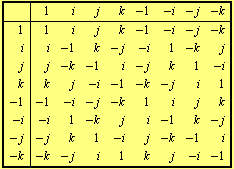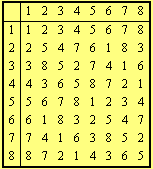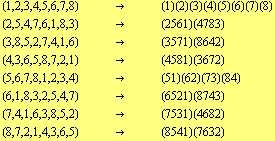 Main Index
Main Index
 Algebraic structures
Algebraic structures
 Structures with one operation
Structures with one operation
 Groups
Groups
 Subject Index
Subject Index
 comment on the page
comment on the page
 Main Index
Main Index
 Algebraic structures
Algebraic structures
 Structures with one operation
Structures with one operation
 Groups
Groups
 Subject Index
Subject Index
 comment on the page
comment on the page
Theorem (Cayley 1878). Every finite group of order ![]() is isomorphic to a group of permutations on
is isomorphic to a group of permutations on ![]() elements.
elements.
Proof: We give an algorithm for a construction of such an isomorphism. If ![]() is the given group, let
is the given group, let ![]() denote the group of permutations of the set
denote the group of permutations of the set ![]() with the standard composition
with the standard composition ![]() of permutations.
of permutations.
For ![]() define the map
define the map ![]() . This map is a biject due to the group axioms. It remains to prove that the map
. This map is a biject due to the group axioms. It remains to prove that the map ![]() is an isomorphism, i.e. that
is an isomorphism, i.e. that ![]() . To see this, let
. To see this, let ![]() . Then
. Then ![]() , or
, or ![]() , that is
, that is ![]() is a homomorphism. To prove that it is also injective it is sufficient to prove that the its kernel is trivial. If
is a homomorphism. To prove that it is also injective it is sufficient to prove that the its kernel is trivial. If ![]() , where
, where ![]() is the identical map, the due to the definition of
is the identical map, the due to the definition of ![]() we have
we have ![]() with
with ![]() the identity of
the identity of ![]() . On the other hand
. On the other hand ![]() , i.e.
, i.e. ![]() showing that the kernel of
showing that the kernel of ![]() is trivial.
is trivial.
The proof of Cayley’s theorem for finite groups depends on the fact that the group elements in a row of the Cayley table form a permutation of the original listing of the elements of the group. This observation gives another form of the previous proof is this: If ![]() is the standard representation of a permutation of an
is the standard representation of a permutation of an ![]() -element set, then denote by
-element set, then denote by ![]() the permutation
the permutation ![]() . In this notation
. In this notation ![]() . Note that each element
. Note that each element ![]() corresponds to a permutation
corresponds to a permutation ![]() which consists of cycles which are of the same length and the length of each of the cycles in
which consists of cycles which are of the same length and the length of each of the cycles in ![]() is just the order of
is just the order of ![]() .
.
For instance the Cayley table of the quaternion group  is
is

If we substitute for the quaternions the numbers ![]() then the previous table takes the form
then the previous table takes the form

The rows as permutations of the basic set ![]() have the following cycle decompositions:
have the following cycle decompositions:

There is one further interesting fact contained in the above proof. The isomorphic image of ![]() is a subgroup of
is a subgroup of ![]() having order equal to the number of permuted elements and every permutation in the subgroup with the exception of the identity element has no fixed point. Such subgroups of the symmetrical group are called regular.
having order equal to the number of permuted elements and every permutation in the subgroup with the exception of the identity element has no fixed point. Such subgroups of the symmetrical group are called regular.
Even if the proof of the theorem was constructive it is not always effective in the sense that the group ![]() is not “small” enough. For instance, let
is not “small” enough. For instance, let ![]() be the symmetry group of the equilateral triangle. Then
be the symmetry group of the equilateral triangle. Then ![]() is the symmetry group on 3 elements, that is, it has
is the symmetry group on 3 elements, that is, it has ![]() elements. In the above construction
elements. In the above construction ![]() is the symmetry group of a 6-elements set which has
is the symmetry group of a 6-elements set which has ![]() elements.
elements.
Note that every finite group ![]() can be embedded into the alternating group on
can be embedded into the alternating group on ![]() elements which order is
elements which order is ![]() for
for ![]() .
.
Corollary. There exists only finitely many non-isomorphic groups of given order ![]() .
.
Corollary. The set of all non-isomorphic finite groups is countable.
Cayley’s theorem can be easily extended to infinite groups using formally the same idea:
Theorem . Every group of cardinality ![]() is isomorphic to a group of bijective transformations of a set of cardinality
is isomorphic to a group of bijective transformations of a set of cardinality ![]() .
.
A permutation representation of a group G is a homomorphic representation of G as a group of permutations of a set. It is called faithful if the representation is injective.
A further generalization we get starting with a subgroup ![]() of finite index in a group
of finite index in a group ![]() (nor necessarily finite). Let
(nor necessarily finite). Let ![]() be the set of right representatives of the right cosets
be the set of right representatives of the right cosets ![]() with respect to
with respect to ![]() then define
then define ![]() .
.
Theorem. The above mapping is a homomorphic representation of the group ![]() . The kernel of this representation is a normal subgroup
. The kernel of this representation is a normal subgroup ![]() of
of ![]() , namely that which is maximal among those contained in
, namely that which is maximal among those contained in ![]() .
.
Proof. That the mapping is homeomorphism is immediate. To prove the rest of the statement, let ![]() be its kernel. If
be its kernel. If ![]() then
then ![]() , i.e.
, i.e. ![]() for all
for all ![]() . If we denote
. If we denote ![]() , then
, then ![]() . The intersection on the right hand side is clearly a normal subgroup of
. The intersection on the right hand side is clearly a normal subgroup of ![]() contained in
contained in ![]() . Since every normal subgroup of
. Since every normal subgroup of ![]() contained in
contained in ![]() is contained in
is contained in ![]() for each
for each ![]() ,
, ![]() . Thus
. Thus ![]() and
and ![]() . In the opposite direction, if
. In the opposite direction, if ![]() , then
, then ![]() implying
implying ![]() , i.e.
, i.e. ![]() .
.
Using Lagrange’s theorem  we get:
we get:
Corollary. Each subgroup of finite index ![]() contains a normal subgroup of finite index, which is divisible by
contains a normal subgroup of finite index, which is divisible by ![]() and divides
and divides ![]() .
.
| [1] | Kargapolov, M. I., & Merlyakov, Y. I. (1982). Foundation of Group Theory (Russian). Moscow: Nauka. |
Cite this web-page as:
Štefan Porubský: Cayley’s Group Theorem.